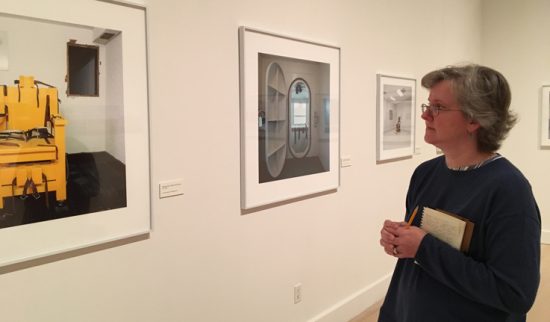“Idaho. I know somebody who was almost executed there.”
UNCG sociology professor Dr. Saundra Westervelt views Lucinda Devlin’s “Omega Suites” photographs in the Weatherspoon Art Museum with an inroad to their significance. She’s a leading researcher on death row exonerees, and she’ll speak about the photographs in a special event in the gallery on March 2.
“Illinois, where they no longer have a death penalty. I have several very close friends who were almost executed here.”
The photographs from Devlin’s most celebrated collection show empty, clean execution chambers, each with a distinct personality. Westervelt has known people who have lived near them for 20 or more years, before they were proven innocent and released from death row.
“Oh, Yellow Mama, in Alabama,” she says, pausing in front of the photograph of the chair, which was intentionally painted a commanding bright yellow. “This particular chair, in the circles of people who study the death penalty, is famous.

Westervelt and her colleague Dr. Kim Cook (UNCW) compile the stories of innocent people who have been convicted of capital crimes, incarcerated on death row and later released because of their factual innocence. Together, they have interviewed many exonerees and written extensively about the challenges they face in “Life after Death Row: Exonerees’ Search for Identity and Community,” published by Rutgers University Press. Westervelt is also co-editor of a collection of essays, “Wrongly Convicted: Perspectives on Failed Justice” and an edition of the Albany Law Review dedicated specifically to the aftermath issues experienced by exonerated death row survivors. Before she began her research, little was known about the lives of exonerees after prison, and few resources were available to them.
Through her research, she knew Walter McMillan, one subject of “Just Mercy,” an award-winning memoir by attorney Bryan Stevenson. Recently, Westervelt has led discussions on Stevenson’s work at a Friends of the UNCG Libraries event and at Scuppernong Books.
“He was put on death row before he was even convicted,” she shares about Walter McMillan, who lived in close proximity to Yellow Mama for six years, and expected to end his life there, she says.
Westervelt also counts among her close friends Kirk Bloodsworth, the first death row DNA exoneree in the entire United States. Following his exoneration, Bloodsworth worked with Congress to pass the Innocence Protection Act of 2003, and established the Kirk Bloodsworth Post-conviction DNA Testing Program, to protect other innocent people.
“Innocence is a very powerful thing,” Westervelt says, explaining that a high number of death row exonerees has led to the banning of the death penalty in some states, such as Illinois.
“Virginia. I’ve known a lot of people who were almost executed in that chair.”
In all the photographs of the immaculately clean execution chambers, Westervelt notices Devlin revealing “the attempt to sanitize it.” But the many exonerees Westervelt has interviewed would say it’s not possible.
“If you’re looking for a sanitized, painless way to kill people, you’re not going to succeed. On death row there’s this pervasive atmosphere of death, because everybody there is waiting to be killed. It’s a place of despair.”
Westervelt is vice chair of the board of Witness to Innocence, the only national organization whose members are solely death row exonerees, and she will attend the annual conference in April. She explains that the “Innocence Movement” took shape in the late nineties and early 2000s.
“The more that those cases became public, it made people think twice.” As public awareness increased, the United States’ use of the death penalty began to decline, after the height of its use in the late 1990s. Currently, 31 states have a death row, including most of those shown in Devlin’s photographs.
“So that’s death watch. Final holding cell. That’s Baltimore. That’s Raleigh.”
Westervelt is now gathering data on North Carolina exonerees, studying reparations, compensations and lawsuits. She also is working with a sociology graduate student, Tiffany Merritt, to gather information on the reparations received by all 157 death row exonerees in the U.S. One thing she has found that exonerees rarely get: an apology.
“That’s what they say they really want more than anything.”
She says that the people she knows who were exonerated from death rows are very lucky, and adds, “To think that there aren’t more people who are innocent who will be executed is just wishful thinking. They just aren’t lucky.”
Westervelt will speak on Devlin’s “Omega Suites: The Architecture of Capital Punishment” this Thursday, March 2, at 6 p.m. in the Bob & Lissa Shelley McDowell Gallery at the Weatherspoon Art Museum.
By Susan Kirby-Smith






